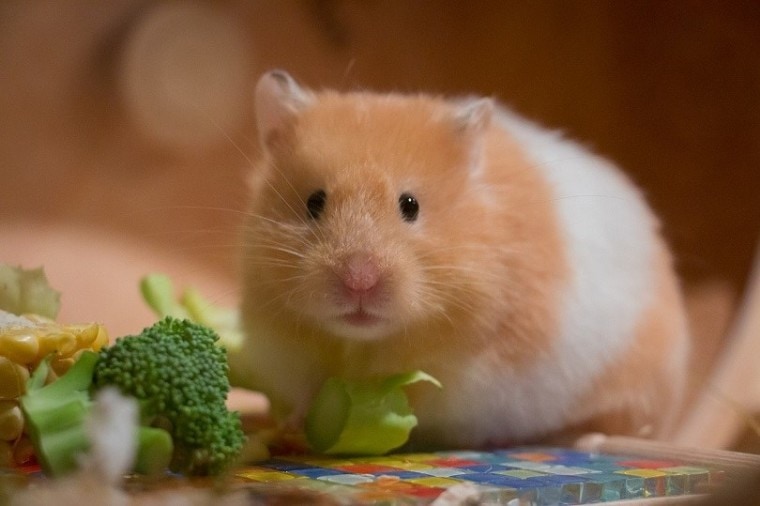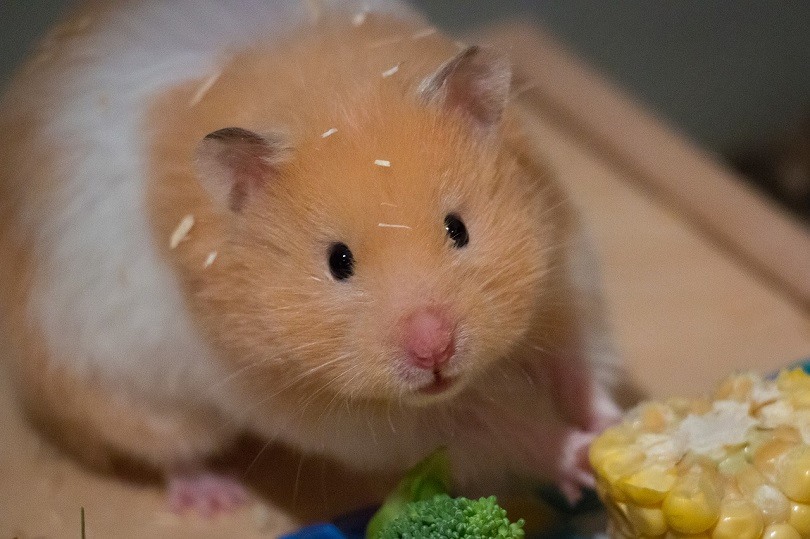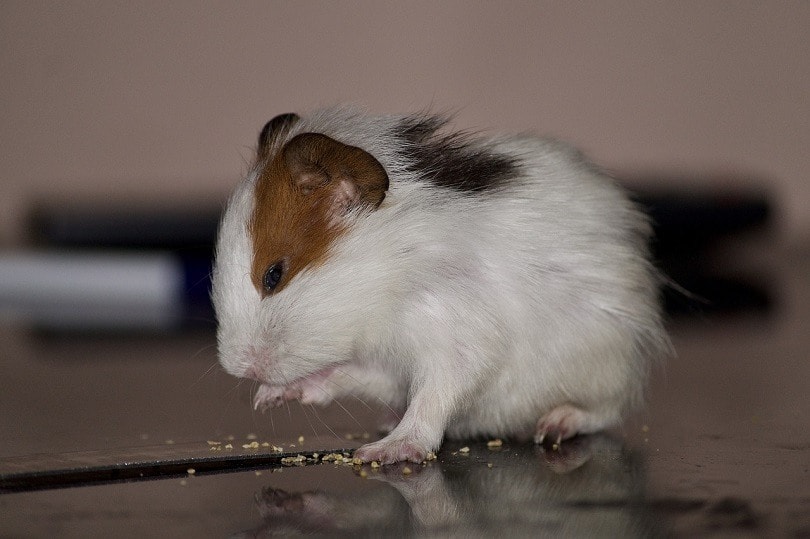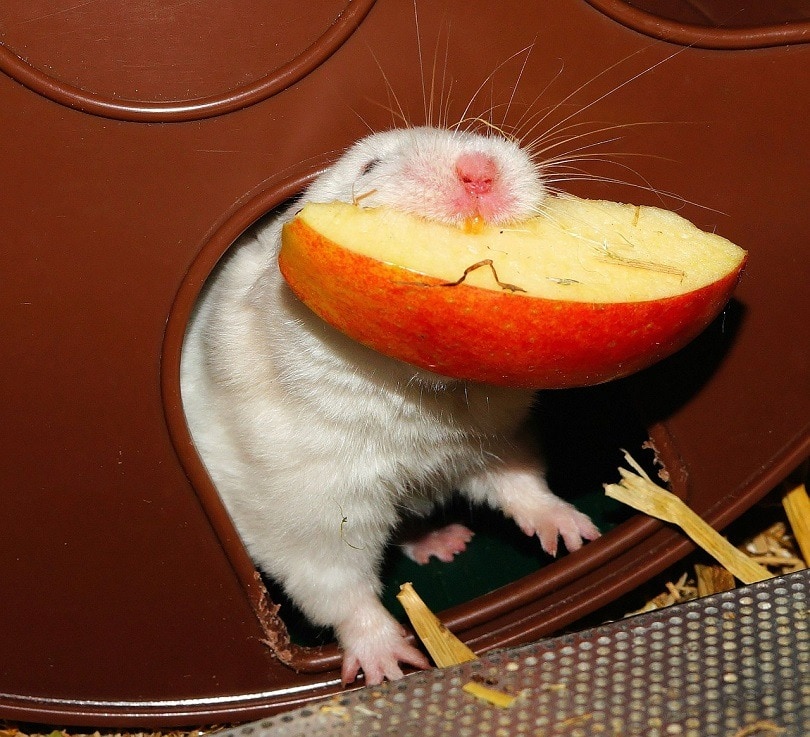How Often Dobnbi Feed My Hanster

Hamsters are small animals, and it can be difficult to gauge exactly how much to feed them, especially if you are a new hamster owner.
The amount that you feed your hamster largely depends on their weight and age, but in general, a hamster will eat around 2 tablespoons of food mix per day. Smaller hamsters, such as Dwarf varieties, will only need around 1 tablespoon per day. If you notice that your hamster is not finishing their food or that they are rapidly gaining weight, you are probably feeding them too much. If they finish their food rapidly, you may need to increase their portions slightly.
Hamsters can hold a large amount of food inside their cheeks. Some people estimate that they can hold as much as the equivalent of their own bodyweight in cheek storage! Stashing food away is perfectly normal behavior for hamsters, but if you notice them storing large amounts of their food away, you are probably giving them too much.
In this article, we go in-depth on how much to feed your hamster, how often, and what foods are best and what foods to avoid. Let's get started!
What Do Hamsters Eat?
Hamsters are omnivores, meaning they mainly eat food sourced from plants, but in the wild, they are known to snack on insects and small frogs and lizards. A hamster's diet should consist of around 15% protein and no more than 5% fat. In general, the best food to give your hamster in order to provide them with all the essential vitamins and minerals that they need are commercial hamster pellets.

Commercial pellets will give your hamster a healthy, balanced diet with every bite and prevent them from picking and choosing what they prefer. With loose seed mixes, hamsters will often only eat their favorite items and leave the rest, resulting in an unbalanced diet. Pelleted hamster diets largely solve this problem, but they should be as high-quality as possible and free from any unnecessary ingredients. Still, this can get monotonous for your hamster, and you should supplement this with seeds, nuts, vegetables, and fruits occasionally.
The best hamster diet consists of commercial pelleted food combined with a variety of fresh fruits, seeds, and vegetables.
In general, a captive hamster's diet consists of:
- Timothy hay
- Commercial hamster pellets
- Seeds
- Grains
- Nuts
- Corn
- Fruits
- Vegetables
- Mealworms
- Crickets
Foods to avoid at all costs are:
- Raw beans
- Raw potatoes
- Apple seeds
- Almonds
- Citrus
- Garlic
- Onions
- Rhubarb
- Chocolate
- Sugar

Hamster Feeding Chart
| Veggies and Green | Grains | Fruits | Proteins | Fats |
| Lettuce | Cooked brown rice | Apple (no seeds) | Hard-boiled eggs | Pumpkin seeds |
| Kale | Whole-grain cereal | Cantaloupe | Mealworm | Sunflower seeds |
| Dandelion green | Cooked whole-wheat pasta | Banana | Crickets | Pistachios |
| Spinach | Oats | Blueberries | Cooked chicken | Pecans |
| Cucumber | Barley | Peaches (no pit) | Dubai roaches | Brazil nuts |
| Frequency and Amount | ||||
| Daily 1-2 tsp. | Daily 0.5-1 tsp. | Every other day < 1tsp. | 2-3 times/week 0.5 tsp. | 2-3 times/week 0.5 tsp |
Source: https://www.oxbowanimalhealth.com/blog/healthy-treats-and-foods-for-hamsters-and-gerbils

How Often to Feed Hamsters
You should only fill your hamster's meal bowl once a day, as hamsters are known to store a large amount of food in their cheeks and their bedding. They should finish this stored food before eating fresh food to prevent it from going stale and causing health issues.
Most hamsters will need no more than 2 tablespoons of pelleted food every 24 hours. Dwarf hamsters will need a bit less, roughly 1 tablespoon, while larger hamsters like Syrians will likely need a bit more. If your hamster is gaining weight and storing loads of food, you may need to reduce the amount. If your hamster is finishing all their food and not storing much, you'll need to slightly increase their daily amount.
Younger, high-energy hamsters will also eat more on average than older hamsters, and the same goes for pregnant and nursing mothers. Once the babies have weaned, you can begin to lower the mother's food intake gradually.
Essential Treats for Hamsters
Hamsters love fruit, so fruits make a great occasional treat for them. Remember, most fruits are high in sugar and should be given sparingly.
Healthy fruit treats include:
- Apples (seedless)
- Bananas
- Blackberries
- Blueberries
- Grapes
- Kiwi
- Mango
- Peach (pitted)
- Strawberries
- Pears (seedless)
A large variety of vegetables are also great treats for your hamster, including:
- Cucumber
- Carrots
- Broccoli
- Celery
- Green beans
- Turnip
- Sweetcorn
- Lettuce
- Kale
- Spinach
Seeds and nuts can also be given safely to hamsters in moderation, including:
- Peanuts
- Pecans
- Walnuts
- Pumpkin seeds
- Sunflower seeds
- Flax seeds
- Sesame
Remember that while mixed seeds are great, your hamster is likely to pick out only the ones that they enjoy, resulting in your hamster's diet being unbalanced. Also, any seed mixes given to your hamster should be in their raw forms and specially formulated for hamsters, as human-formulated mixes often contain salt, sugar, and other additives.
Do Stashes Need to be Removed in a Hamster's Cage?
In general, you should not remove your hamster's stash. This will cause them stress when they find that their stored food has suddenly vanished! Dry, pelleted food and seeds can last for quite some time, and it's advisable to put their stash back exactly where you found it after cleaning their cage. The exception is if there are urine or feces on the food or if they have stashed fresh food, like vegetables and fruit. If you are really concerned, skip a day or two of feeding so they'll finish their stash.

Do Hamsters Need Supplements?
If your hamster diet is healthy, balanced, made up of pellets and fresh fruits and vegetables, lives in a clean environment, and gets plenty of exercise, there is usually no need for supplements. Some hamster owners give their hamster extra vitamin supplements, but with a healthy lifestyle, these won't help much. Also, it's exceedingly difficult to judge how much they need, and they could end up having too many certain vitamins.
Some of these supplements contain fat-soluble vitamins A and D, both of which are not excreted by urine and could result in an overdose. Water-soluble vitamins, like vitamin C, are safe, though arguably unnecessary in healthy hamsters.
The only time when supplements are potentially helpful is when your hamster is having certain health issues and they are recommended by a vet.
What to Do If Your Hamster Isn't Eating
Usually, it's a sign that your hamster is not feeling well if they have stopped eating. However, they could also simply be hoarding their food! Check their bedding for food that they may be keeping for a late-night snack, but do not remove it. If your hamster is not hoarding food and not eating, they are most likely sick and need to see a vet. This is usually accompanied by other symptoms, like weight loss and lethargy. If there are no other symptoms and they seem well but are still not eating, they may simply be bored of their food! Mix up your hamster's diet a bit and add in occasional healthy treats.
Conclusion
Feeding your hamster 1-2 tablespoons of food per day is a good general rule of thumb to go by, depending on their size. Hamsters love to store food, so be sure to check their stash before upping their daily food intake to avoid obesity. If their stash is looking a bit hefty, you may want to skip a day or two of feeding to get them to finish what is stored. While occasional fresh vegetables and fruits are essential, make sure to remove any leftovers from your hamster's cage so there is none for them to add to their stash!
Featured image credit: mordilla-net, Pixabay
mcguirearniagaten.blogspot.com
Source: https://petkeen.com/hamster-feeding/
0 Response to "How Often Dobnbi Feed My Hanster"
Post a Comment